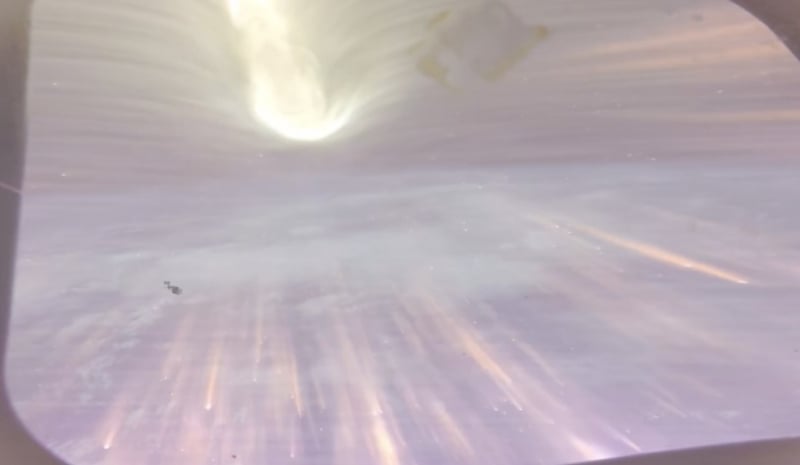
NASA video shows what is seen and heard in lunar ship returning to Earth at speed of 40,000 km/h
A year after the completion of the Artemis-1 mission, NASA has revealed what it's like to be inside the Orion spacecraft during its return to Earth from the Moon. As part of the Artemis-2 mission, Orion will transport astronauts from Earth to lunar orbit and then bring them back to our planet. The spacecraft travels at a speed of around 40,000 km/h, and during its descent to Earth, it can heat up to 2760°C. These sensations—both auditory and visual—have been captured by the spacecraft's cameras.
With less than a year until the planned launch of the Artemis-2 mission, the NASA crew has already begun preparations for this historic journey. With each mission, NASA is increasing the number of milestones it aims to achieve. For instance, while Artemis-1 saw the unmanned Orion spacecraft orbit the Moon and return to Earth, Artemis-2 is planned to have a crewed Orion orbit the Moon on a different trajectory before returning to Earth.

Similar to SpaceX's Crew Dragon spacecraft, NASA conducted tests of the Orion spacecraft's ability to transport crews during the Artemis-1 mission. Currently, astronauts are preparing for the journey around the Moon. Reid Wiseman, Victor Glover, Christina Koch, and Jeremy Hansen spent December practicing emergency exits from the spacecraft after landing.
The Orion spacecraft is designed to withstand extreme speeds and external forces during its return from the Moon. These parameters are typically higher and more substantial than those experienced by crews and cargo spacecraft flying to the International Space Station (ISS). Additionally, Orion uses an innovative "overshoot" maneuver to enter the atmosphere and reduce its speed. During this maneuver, Orion appears to "dive" into Earth's atmosphere, then gains altitude again. This allows the spacecraft to improve landing accuracy, enhance the performance of the heat shield, and reduce the G-forces experienced by astronauts entering Earth's atmosphere.
Similar to SpaceX's Crew Dragon spacecraft, NASA conducted tests of the Orion spacecraft's ability to transport crews during the Artemis-1 mission. Currently, astronauts are preparing for the journey around the Moon. Reid Wiseman, Victor Glover, Christina Koch, and Jeremy Hansen spent December practicing emergency exits from the spacecraft after landing.
The Orion spacecraft is designed to withstand extreme speeds and external forces during its return from the Moon. These parameters are typically higher and more substantial than those experienced by crews and cargo spacecraft flying to the International Space Station (ISS). Additionally, Orion uses an innovative "overshoot" maneuver to enter the atmosphere and reduce its speed. During this maneuver, Orion appears to "dive" into Earth's atmosphere, then gains altitude again. This allows the spacecraft to improve landing accuracy, enhance the performance of the heat shield, and reduce the G-forces experienced by astronauts entering Earth's atmosphere.
- Related News
- Wheel of Death: new method will help astronauts stay fit in low gravity
- Due to anomalies of Orion spacecraft, lunar exploration program may be delayed for years։ NASA
- TAO Observatory: World's highest telescope to study evolution of galaxies and exoplanets
- Powerful M9.5 solar flare causes radio blackout in Pacific Ocean
- What will happen to the Earth if the Moon disappears?
- Key to conquering the Red Planet: Why is NASA studying solar storms on Mars?
- Most read
month
week
day
- Digital Julfa Network is launching a pan-Armenian centre in the metaverse, on the Fastexverse virtual platform 910
- Xiaomi unveils exclusive Redmi Note 13 Pro+ dedicated to Messi and Argentina national team 794
- Sparkles: Boston Dynamics unveils a furry robot dog that can dance (video) 793
- Is there a ninth planet in the solar system? Scientists find new evidence 670
- Smartphone catches fire in child's hand in Russia 655
- What will happen to the Earth if the Moon disappears? 645
- How to understand how protected a smartphone is from water and dust? 636
- World's largest 3D printer was created in USL It prints 29 meter-long structures 620
- iPhone 16 may get colored matte glass back panel, 7 colors 610
- New iPad Pro to receive M4 chip and to be more powerful than Apple computers 609
- Archive
